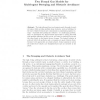Free Online Productivity Tools
i2Speak
i2Symbol
i2OCR
iTex2Img
iWeb2Print
iWeb2Shot
i2Type
iPdf2Split
iPdf2Merge
i2Bopomofo
i2Arabic
i2Style
i2Image
i2PDF
iLatex2Rtf
Sci2ools
FAABS
2004
Springer
2004
Springer
Two Formal Gas Models for Multi-agent Sweeping and Obstacle Avoidance
Abstract. The task addressed here is a dynamic search through a bounded region, while avoiding multiple large obstacles, such as buildings. In the case of limited sensors and communication, maintaining spatial coverage – especially after passing the obstacles – is a challenging problem. Here, we investigate two physics-based approaches to solving this task with multiple simulated mobile robots, one based on artificial forces and the other based on the kinetic theory of gases. The desired behavior is achieved with both methods, and a comparison is made between them. Because both approaches are physics-based, formal assurances about the multi-robot behavior are straightforward, and are included in the paper. 1 The Sweeping and Obstacle Avoidance Task The task being addressed is that of sweeping a large group of mobile robots through a long bounded region (a swath of land, a corridor in a building, a city sector, or an underground passageway/tunnel), to perform a search, i.e., survei...
| Added | 01 Jul 2010 |
| Updated | 01 Jul 2010 |
| Type | Conference |
| Year | 2004 |
| Where | FAABS |
| Authors | Wesley Kerr, Diana F. Spears, William M. Spears, David R. Thayer |
Comments (0)

